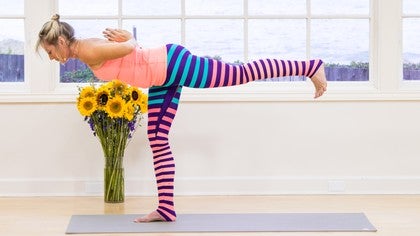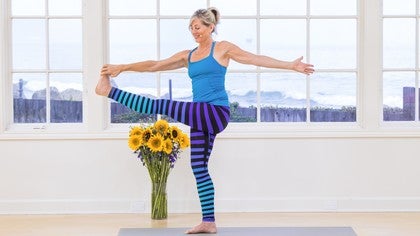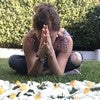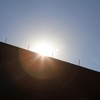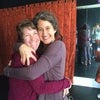Description
About This Video
Transcript
Read Full Transcript
(gentle ocean waves) Namaste. This particular series, I use every time I come to my mat, and what I want to be sure I do as I move into my practice, is check to see what's happening inside my body, because as we likely know, if we've had already had a day of activity and circumstance, a lot of that stuff gets in here, and we're not necessarily aware of it until we arrive, so this short series helps me to check in, and I wanna share it with you, and I wanna be sure that I've employed the ingredients that I need to have a really lovely practice, okay? So here we go. We'll come first to Child's Pose, Pose of the Child, beginner's mind, let's start there. So I like to have my arms out in front, and I turn my palms up and bring the forehead to the mat, and just feel the forehead make contact with the mat.
And as I begin to notice how I'm feeling in my body I might offer away, this is why the palms are up, offer away anything that has been on my mind that would keep me from being present. And then I begin to turn my attention to how I'm breathing. It's gonna be in and out through the nose, and I just notice, do I feel my belly expand on the inhale, release on the exhale. Do I feel my rib cage expand? And then what's happening at the top chest, can the breath go up into the top chest at all?
And then I check with the back of my lungs, because the back of the body, we just don't think about very often. And then placing the palms down, slide the hands in beneath the shoulders, slowly rise. So that information's helpful, because I ideally in my practice I'm gonna have the breath be largely top chest, but if I were anxious, and I was only breathing in my top chest, then I would work with getting the breath down a little bit lower before I went there. So it's important to notice, oh yes indeed, all of this is functioning. Now, in the morning, if this practice is in the morning for you, and you have not eaten yet, this part's really important, you could take your hands, lay one on top of the other really low right down by the intestines, and we'll do this breath.
And if you have been moving about today and already eaten, then just skip this part, okay? I'll show you something else you can do. We'll inhale, lengthen. Exhale, through the mouth, rounding. (exhales heavily) Inhale.
(exhales heavily) Three more. (exhales heavily) (exhales heavily) (exhales heavily) Good, and slowly rise back up. Just a natural breath. And take one more. So if that breath wasn't for you, that really helps to like wake everything up down here low.
You could take up all the body breath, where the hands come to the belly, it's a short series of exhalations like this, it's all through the nose, we'll do 20. (short, rapid exhalations) Take a deep breath in. Exhale through the nose. Just notice the effect on that. So that breath is really useful for chest and sinuses, if you've got anything going on with lungs and sinuses, very very useful.
But let's say this has been a crazy day, and so much has happened, then I would start with alternate nostril breathing, just to bring that energy down. And that's why it's so important in the beginning of the practice, to know, well, how am I feeling? So that we can make the right choices with these tools that we have. So two fingers, I place on my forehead center, my thumb tip comes to my right nostril, my ring finger will come to my left. And first, ring finger to left, I'll inhale through the right.
And close the right with the thumb tip, exhale through the left. Inhale left. Close left, exhale right. And I use the image of a silk thread, so very quiet breath, long, inhale. Closing and exhale.
Might take two more at your own pace. Your pace is different than mine. When you're ready, just go ahead release the hands, just pause here, feel the breath move in and out through both nostrils, it's nice to remember that we are being breathed. Good, so make your choice, when you develop your own practice, make your choice about which one's right for you, we'll slowly come forward into Puppy Pose, sometimes called Melting Heart posture, and essentially we're just allowing the heart to make its way to the floor, lengthening the spine. You can have toes tucked under or feet flat, depending on what feels best for you.
And I like to have my fingertips on the floor, so there's a little bit of pulling. And I'm widening the sit bones. And lengthening the space under the arm pits. Now, when I make my way up, I'm gonna just sort of curl my tailbone under and come right into what is often referred to as Angry Cat. This mushrooming the upper back, then taking a couple breaths here, we'll inhale here.
And we'll exhale here. And leading with the sacrum, just begin the motion. So eventually the head is in response to the rest of the spine, inhaling. Let's exhale through the mouth, rounding. Sacrum leads the way, inhaling.
And exhaling. (exhales heavily) Three more at your own pace. (exhales heavily) (exhales heavily) A good one more, for good measure, inhaling. And exhaling. (exhales heavily) Good, so the purpose of that is just to feel as though there's a fluid spine, very important, for so many of these postures, and we're gonna go in the opposite direction now, the left leg goes back, and I will often refer to my foot in this posture as the Barbie foot.
So, reach back through the ball of the foot, the right arm extends forward, and I'm looking for a long line here. I'm using my breath to inhale, lengthen the back leg and the front arm, and exhale, pause in that length. And my lower ribs are making their way towards the hips. So I feel connected to my lower body. Gaze is steady, breath is steady.
Inhale here, exhale with the breath, lower the hand, and the knee, take a breath. Good, right leg goes back, left arm forward, steady your gaze, steady your breath. Lengthening with the inhale. One more, inhale. Exhaling, hand and knee to floor.
So let's tuck the toes under, shift your hips back, let's start with the knees bent, moving into Downward Facing Dog, it's always nice to sort of pedal out the legs a little bit, create some more length on the back of the legs. Good, now have your spine be long first, be sure that the spine is indeed long, if there's any rounding in the spine, keep the knees bent. And if the spine can remain long, go ahead, begin to straighten the legs. Draw in the outer edges of the heels down, the toes lift off. Now, looking at your arms for a moment, if you could sort of externally rotate the upper arm bones.
And then looking at the navel, draw the lower ribs towards the hips. Lift the kneecaps up with the front of your thigh muscles. Could even try to take the toes off the floor, that can be quite a challenge. You can see that your inner arches are lifted, and that you kind of zipped up, zip up right up the inside of your legs. And steady breath, and inhale here.
Exhale, we'll bend the knees, let's just take a step forward or several steps forward, however many it takes. Go ahead take your hands to your shins, and inhale, lengthen the front spine. Now, lift the kneecaps up with your front thighs, and draw your sit bones way, way, way back behind you. Now, I like to imagine that I'm creating the number seven with my body. Go ahead put the toes back down, but keep the weight back in the heels, draw your shoulders away from your ears.
And draw the lower navel way in. And inhale here. Exhaling, we're gonna fold forward, bend your knees, place your belly on your thighs, grasp your elbows, let's just hang. If it's hard to hang here, hard to balance, go ahead take your feet hip width apart. Just shaking no thank you with the head.
Yes please, with the head. And feeling the breath move into the back of the lungs. You might slowly begin to straighten the legs, just take it easy here, because we really care about our lower backs. Get in one more inhale across the upper back. Then press your heels into the floor, bend your knees and slowly, one vertebrae at a time, the navel draws into the spine, we're gonna rise all the way up.
Extend the arms up. Good, now, for a moment, interlace your fingers, turn the palms up, have your feet together, squeeze everything together, and imagine that somebody's got their hands on your rib cage and they're lifting your rib cage up. Make more room for your organs. And in fact, imagine somebody's got their hands on your hip bones, and they're lifting them as well. So, very tall.
It's okay to have your shoulders around your ears for this. And inhale here. Exhale, let's release the arms. Coming into Tadasana, Mountain Pose. So, neutral in all respects, it's a fascinating posture, the idea of being that every posture that we take through this series has the same inner quality as Mountain.
So we're looking for vertical, you might close your eyes, if it's easier to find vertical line through the body. Feel the heels through your arches lifted, the inner line of the legs zipped up. How the pelvic floor helps to contain the rib cage, over the hips. Let the shoulders soften. Let the occipital ridge of the back of your neck lift just a little bit.
And feel what it feels like to be in this posture, make it easy for yourself. Okay, now we've got that, we can remember that, because that's what we're looking for. And we're gonna inhale, extend the arms all the way up, now go ahead, interlace your fingers once again. And then inhale again, take a deep breath through the nose. Exhale, we'll extend off to the right.
Let your left hip move to the left. Inhale, rise up. Exhale, extending. Take your breath to the right side. Inhale, come back up.
Exhale, palms face one another, we'll sit down here, and Utkatasana, Chair Pose, let the sit bones draw back, as if there was a chair back there. Line up your hips, very easy to kind of scoop out here, keep a connection from the lower ribs to the hip bones. Like lightning bolt. Inhale here, exhale palms in prayer position, pause. And we'll see if you could take your left foot off the floor, some of you might keep just the toes on the floor.
We're gonna see if the left ankle will cross over the right thigh, palms in prayer position, steady your gaze. Can you set the elbows down lightly? Or, be up here. Good, inhale, rise up just enough to set your foot back down. Come back into Chair Pose.
And perhaps other side, crossing. Foot stays flexed to protect your knees. Sit down a little bit. And remember how the breath is moving to the top chest. So your lower navel stays in to help support you.
Good, rise up a bit, place your foot back down. Good, inhale, extend up. Exhale, we're gonna make our way down, bring the hands to the floor out in front of you, bend your knees, this is tricky posture. So, this is a squat with the legs together. And, some of you are gonna find that the heels come to the floor quite easily, that is not the case for me.
I do this posture every day because it's really good for the Achilles tendon and the back of the calves. So you might take your fingers forward. If your heels are down, you can bring your palms together in prayer position, but I'm gonna do my work here. (exhales heavily) Now, bring your hands to the floor. Elbows draw back, you can step back to plank, or you can hop back to plank from here, draw your lower navel in, and back we go, pushing back through the heels first.
Wake up the fascia, the soles of the feet. Good, your fingers are spread wide apart, you're making your body into a board. Absolutely into a board, grow, grow, grow. The tendency is for the hips to be up or down, stay right here. Some of you will find knees to the floor, good idea to maintain your integrity.
Good, now we have big choices to make. Inhale, exhale, either right knee down, turn, come to Vasisthasana as a prep pose. Left arm goes up, right shoulder way down the back, or the full Vasisthasana right leg long. Feet are flexed, left arm up. We're gonna lower the hand with a breath, inhale.
Exhale slowly, slowly. Come to the other side, or left knee down. (exhales heavily) Good, go big. Just checking to see, can we feel our energy, internal energy moving through the body pretty equally? Inhale here.
Exhale, the right hand lands, we come back. Now, inhale here, exhale. Knees, chest, and chin. One option, one very viable option, otherwise, body's like a board. Come forward a little bit, lower down.
Draw the shoulder blades in toward each other. Inhale, exhale, lower down. Pause here, on a cheek. So you can have your cheek down on the mat, sometimes it's nice to just be here, but the point of having the belly down on the floor is if you close your eyes and go inside, you wanna ask yourself, well, on my inhale, is my diaphragm drawing down toward my pelvis? And exhaling the diaphragm releases back up.
And if you find that's not the case, that it seems to be going up toward the chest, better not to force anything, just invite it to move down over time, with practice, it will begin to cooperate. But this is great for really healthy breathing. Good, always nice, if there's anxiety ever, come on to the belly, it's very comforting for the whole body. So let's take the hands now underneath the shoulders, press into your legs a lot. Widen your toes, make it feel as though your pinky toes could touch the ground.
And then, slowly, slowly, press into your legs, pull your mat. Keep your shoulders away from your ears. Pull your mat. Lengthen the front of your spine. Bhujangasana.
Now, I like to keep space on the back of my neck, it's very tempting to wanna draw the head back and up. But I think it's better brain-body connectivity if we don't do that. So if you wish to go on here, we'll move to Upward Dog. Come on to the front of the feet, inhale, lift the body off. Your arms are stick straight.
Your legs are stick straight, you can still feel your pinky toes on the ground. Inhaling. Exhaling, let's all roll right over the toes, or make your way back through Child's Pose, but in any case, we're coming to Downward Facing Dog. Good, now re-route your legs, outer edges of the heels, draw down. So it turns out, that in our lives, modern living, really important that we jump a little bit.
It's good for the body, so I incorporate some jumping into my practice, because I don't jump as much as I used to when I was younger. And so, the way I do it, is I take my gaze very far forward, it's really important that you do, so that you do not fall. Bend the knees, member your navel into your spine. And little hops. And the last one, we'll jump like a frog to the top of the mat.
And settle into Malasana. Take the palms together, elbows pressed, drop your pelvis, lengthen your spine. And then inhale, rise all the way up. And exhale, let's draw the feet together, and come back to Mountain Pose. Find the vertical, I mean, notice that your heart's beating a little bit faster now.
So, from here, what we've done is we've put in all of the ingredients that are important from an inner perspective, as we're moving through the postures. But, we'll now do two Surya Namaskars, Sun Salutation A. And, we won't have all of these postures in them, but I will cue you about certain qualities to remember as you're moving through. I love Surya Namaskar, for lots of reasons. It is said to be very old, it's a prostration, either to the sun, to the god, to the gods, god within.
Our highest self, however you look at it. The way I look at it is, I link postures through the salutation, and it gives me a chance to open the front of the spine, completely, go into the back of the spine, completely. Kind of wash away whatever occurred in the last posture, and then I come to neutral again, just like Mountain Pose. So let's do two of these, shall we? Well, inhale, extend up.
And exhale, folding forward, out and down. Let's bring our hands to our shins, inhale, lengthen the spine. Exhale, palms down, come down into that squat, and then, step or float back, lower through, or, knees, chest, chin. And inhale, Cobra, or Upward Dog. And exhaling back with your navel first.
Downward Facing Dog. Root your legs, lengthen the whole back body, outer upper arm bones turned out and down. Feel entirely integrated here. Which means you can feel your whole self at one time. Inhaling, exhale, knees bent, look past your hands.
Navel to spine. Inhaling, lengthen. Exhaling, folding forward. Inhale, rise all the way up, palms touch. Exhale, palms in Anjali Mudra.
Inhale, arms rise. Exhale, folding forward, long spine. Inhale, lengthening. Exhaling, stepping or floating back, lower through. Inhale, Cobra or Upward Dog.
Exhaling, back over the toes, Downward Facing Dog. Steady breath, steady gaze. (exhales heavily) Inhale here, exhale, bend your knees. Navel to spine. Inhaling.
Exhaling. Inhaling. Exhaling. Just take a breath. Good, so, shall we rest?
Yes, let's rest. Coming down into Shavasana. So here's the point of resting, we just pause for a moment and feel the effects of the practice on our body now. And can I let the body relax and root into the ground? Can I feel the weight of the bones?
Can I let the muscles and the ligaments and the tendons relax a little bit? Can I let the skin soften, skin all over my body, soften? And with my eyes closed, can I feel the energy coursing through my body everywhere? What can I feel, and what can't I feel? Can I observe the body breathing without fixing or changing the breath?
And can I observe the thoughts passing through without getting hooked by any of them? Then, invariably, I will get hooked, eventually, won't be long. And can I let go and let that one go by? So you can see that this is like Mountain Pose, lying on my back, that same sense of equanimity and neutrality, as all of these different weather patterns arrive and pass through the body. So it might feel good to just remain here for a little longer.
If you're ready to close your practice, draw your navel to your spine and bring one leg at a time, and give yourself a hug here. Like you mean it. And send your right arm up over your head, rolling to the right, let your head rest for a moment. And then gradually let's make our way up. Coming to a comfortable seat.
As if we're in mountain pose, just sitting, find again that sense of equanimity. I love this practice so much, because in such a short time, everything can change. All of a sudden, I'm able to observe everything that's occurring. And the circumstances that had a grip on me soften a little bit. Let's bring our palms together, and Anjali Mudra at our hearts.
And we'll close our practice, bring in our hands to our forehead. Right thought, may we be steady, and present, and joyful. The hands come to the mouth, right speech, may our words improve upon the silence, and our hands come to our heart, right action, may we be the change that we wish to see, namaste.
Mandala Yoga
Comments


You need to be a subscriber to post a comment.
Please Log In or Create an Account to start your free trial.


